Why Smart Buyers Choose Pre-Owned: The Used Walk-In Cooler Advantage
A quality used walk in cooler delivers the same dependable cold storage as a brand-new unit while cutting equipment costs by as much as 50 %. That extra capital can go toward staffing, marketing, or simply keeping cash-flow healthy during a busy season.
Key benefits of buying pre-owned:
- Cost savings: up to 50 % versus new
- Quick availability: most units ship in days, not weeks
- Proven reliability: certified technicians inspect and re-condition every system
- Brand variety: hard-to-find names like Bally, Kysor, and American Panel often show up on the secondary market
Typical price ranges:
- Small (5'×4'): $2,900–$5,000
- Medium (8'×10'): $7,000–$12,000
- Large warehouse units: $15,000+
Where to buy:
- Specialized dealers
- Government surplus or school-district auctions
- Online marketplaces such as eBay and other equipment sites
Inventory changes daily, and with nationwide delivery to all 50 states it is easier than ever to match a box to your exact footprint.
I’m Mortuary Cooler, part of the American Mortuary Coolers team. After years of equipping funeral homes across the country, I’ve seen well-maintained used walk-ins run trouble-free for decades while keeping overhead low.
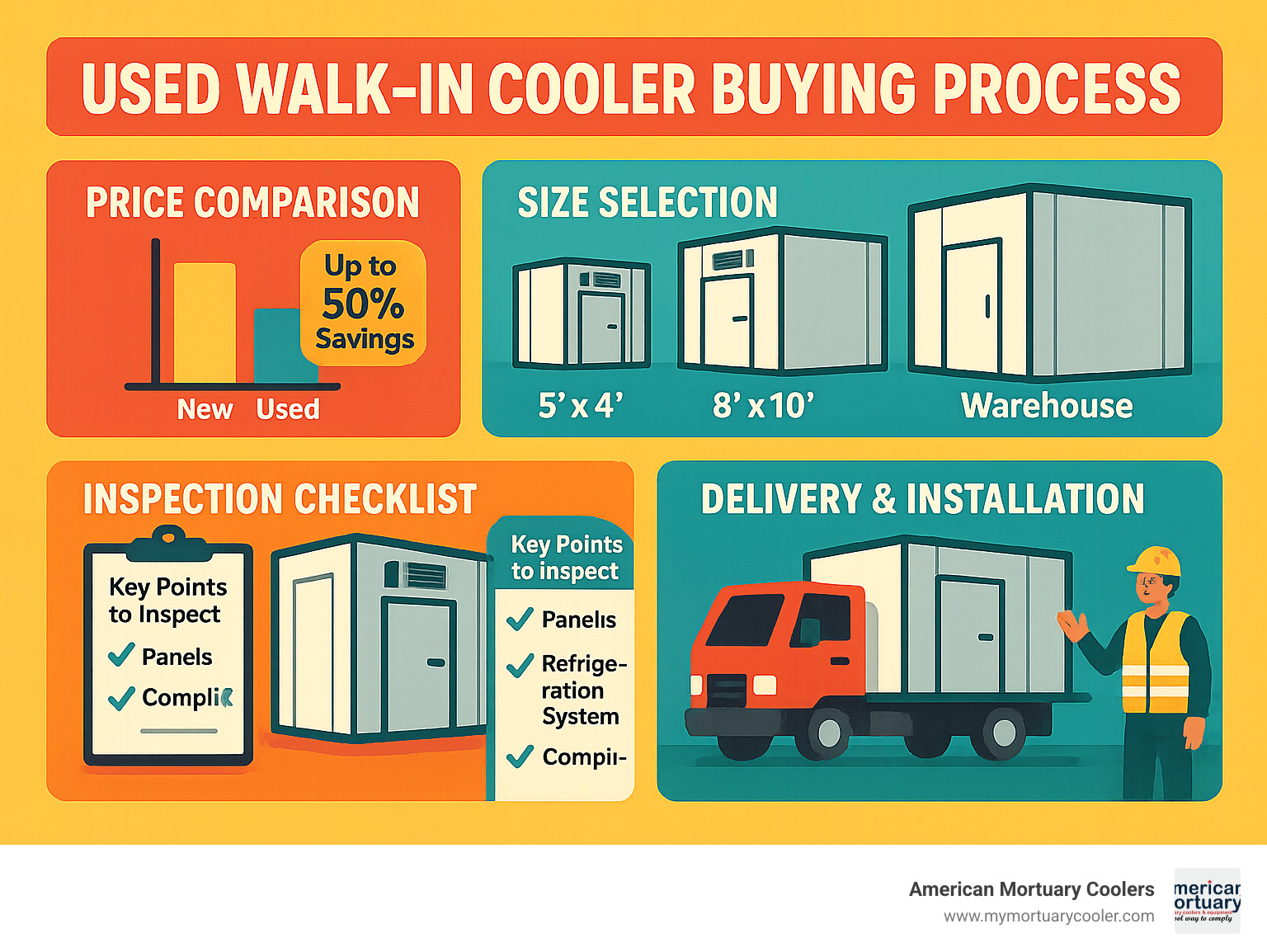
Why Buy Second-Hand? The Benefits of a Used Walk-In Cooler
Let's be honest - nobody gets excited about spending $15,000 on a new walk-in cooler when you could get the same refrigeration power for half that price. That's exactly what happens when you choose a used walk in cooler instead of buying new.
The numbers tell the story. A basic 8'x10' unit that costs $15,000 new can often be found used for around $7,500. That's 50% less than retail, and you're getting the same cold storage capacity that keeps your products at the perfect temperature.
American Wholesale Refrigeration has been proving this point for 28 years. Their certified technicians don't just sell used equipment - they inspect and recondition every unit before it ships. You're not buying someone else's headache; you're getting professionally refurbished equipment that's ready to work.
Here's something most people don't think about: quick shipping. While new units can take 4-8 weeks to arrive, used equipment often ships within days. When your cooler breaks down on a Friday afternoon, waiting two months isn't an option.
The sustainability angle makes this decision even smarter. Every used walk in cooler that finds a new home means fewer raw materials mined, less energy spent manufacturing, and one less unit heading to a landfill. You're participating in the circular economy while saving money - that's what we call a win-win.
Plus, you get access to premium brands like Bally, Hussmann, and Mr. Winter that might be out of budget when buying new. These units were built to last decades, and a well-maintained used unit can deliver the same reliable service as a brand-new one.
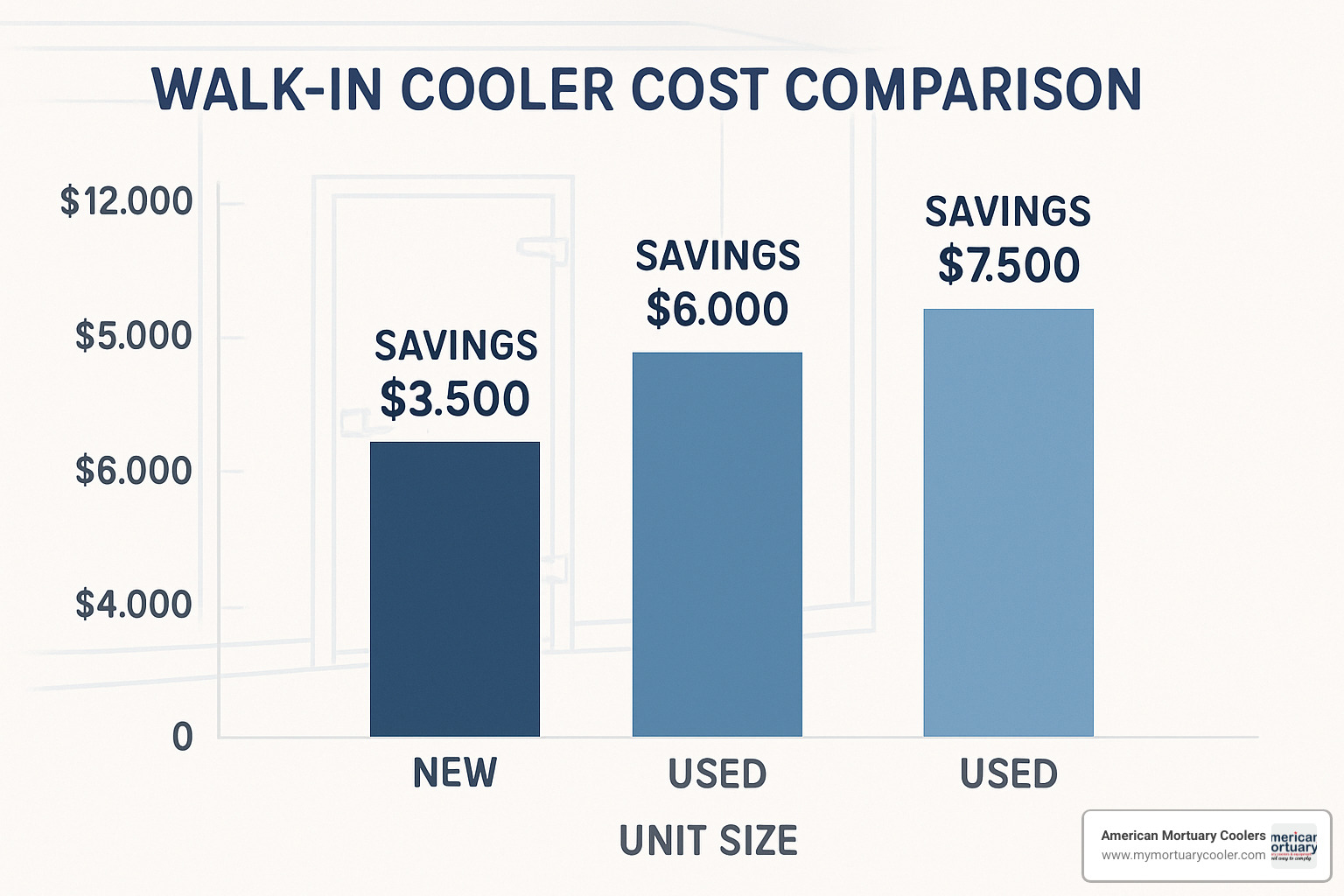
How Used Beats New on ROI
The math on used equipment is pretty straightforward - you typically pay about half the price of new, which means your payback period is cut in half too.
| Unit Size | New Price | Used Price | Savings | ROI Improvement |
|---|---|---|---|---|
| 8'x8' | $12,000 | $6,000 | $6,000 | 100% faster payback |
| 8'x10' | $15,000 | $7,500 | $7,500 | 100% faster payback |
| 16'x12' | $25,000 | $12,500 | $12,500 | 100% faster payback |
But the price gap isn't the only advantage. When you need refrigeration fast - maybe for a seasonal rush or because your current unit just died - faster delivery can save your business. Used units ship in days, not weeks.
Lower depreciation works in your favor too. A new walk-in cooler loses significant value the moment it's installed, like driving a new car off the lot. A well-maintained used unit holds its value much better, so if you need to relocate or upgrade later, you won't take as big a financial hit.
Environmental Perks of Reusing Refrigeration
Choosing used refrigeration does more than save money - it's genuinely good for the planet. The circular economy means keeping functional equipment in use instead of manufacturing new units from scratch.
Many older units can be upgraded to meet modern efficiency standards with reduced carbon impact compared to manufacturing new. LED lighting, modern controls, and high-efficiency condensing units can often be retrofitted for less than the cost of buying new.
The best part? Properly maintained and retrofitted used units can achieve EPA compliance while keeping perfectly good equipment out of landfills. It's environmental responsibility that actually saves you money.
Choosing the Right Used Walk-In Cooler
Finding the perfect used walk in cooler starts with knowing your space and storage targets. The secondary market includes everything from compact 5'×4' boxes that tuck into a back room to 40'×40' warehouse systems that anchor distribution hubs.
Because the panels are modular, you’re not locked into one configuration. Single-temperature coolers, dual-temp combo boxes, and glass-door “beer caves” are all readily available.
When buying used, lean on brands with longstanding parts support. Bally, Kysor, Turbo Air, American Panel, and Mr. Winter have earned solid reputations for durability and serviceability.
Floor style matters too. Some units arrive with insulated floors for freestanding installation, while others are designed to sit directly on a concrete slab. Choosing the correct floor can save thousands in site prep.
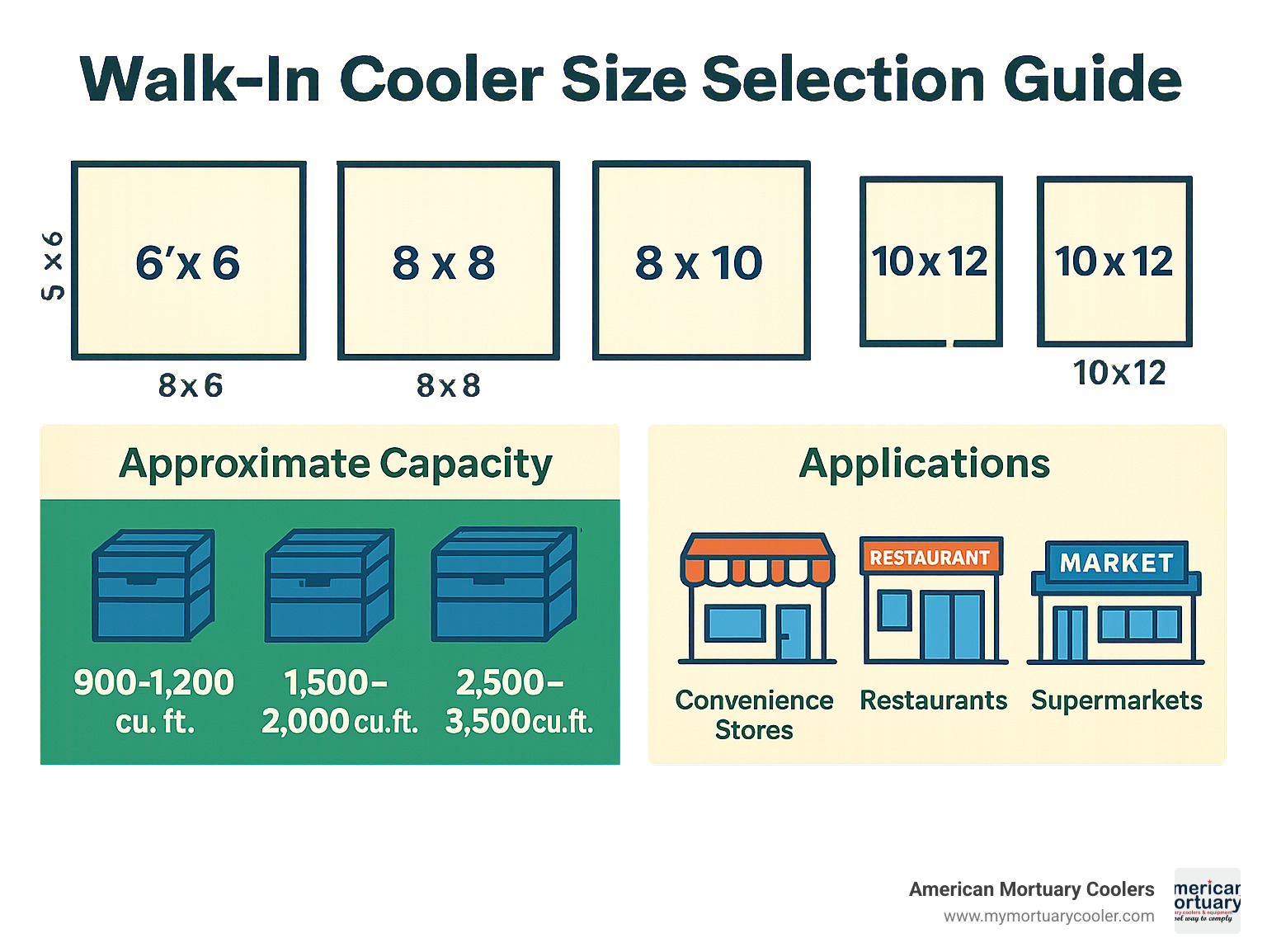
Popular sizes
- 8'×8' (about 95 sq ft): $5,000–$8,000 used
- 8'×10' (about 110 sq ft): $7,000–$12,000 used
- 16'×12' combo units: occasionally appear at auctions for close to $1,000 (buyer handles removal)
Glass-door and beer-cave builds cost more but can boost retail sales by putting product in view.
Brand snapshot & reliability
Bally panels are famously over-engineered, Kysor units excel in large installations, and American Panel’s cam-lock design makes relocation straightforward. Mr. Winter boxes often feature energy-efficient components that transfer well to second-hand ownership.
Price benchmarks
Auction results swing with condition and location. Small self-contained 5'×4' units sometimes hammer for $1,000, while dealer-refurbished warehouse boxes can still be a bargain at $10,000–$15,000. Always focus on condition and maintenance history over age.
(The previously linked third-party product page has been removed to avoid promoting competing vendors.)
Inspecting & Testing Before You Buy
Here's the truth about buying used equipment: you're only as smart as your inspection game. I've seen too many buyers get excited about a great price, only to find expensive problems after the used walk in cooler is already sitting in their parking lot.
The smart move? Always bring a qualified technician for any unit over $5,000. Yes, it costs a few hundred dollars upfront, but it can save you thousands in nasty surprises later.
Start with the panels - they're the heart of your cooler's efficiency. Run your hands along the surfaces looking for any dents, warping, or soft spots that might indicate insulation damage. Quality panels should maintain their R-value of 25 or higher with 4-inch thick insulation. If you find any compromise here, your energy bills will remind you every month.
Floor integrity deserves special attention, especially if you'll be rolling heavy carts or equipment in and out. Walk the entire floor area and feel for any soft spots or bouncing. Check where floor panels meet for separation or gaps. Insulated floors should feel rock-solid underfoot, while non-insulated floors shouldn't show any signs of moisture damage or warping.
The refrigeration system is where things get technical, and honestly, this is where you really need that qualified technician. They'll check compressor hours, verify refrigerant levels, and test how accurately the unit maintains temperature. Refrigerant leaks are expensive to fix and often signal bigger problems lurking in the system.
For a deeper dive into evaluating used refrigeration equipment, check out our guide Cool Deals: A Buyer's Guide to Used Morgue Coolers. The inspection principles apply whether you're buying a mortuary cooler or any commercial refrigeration unit.
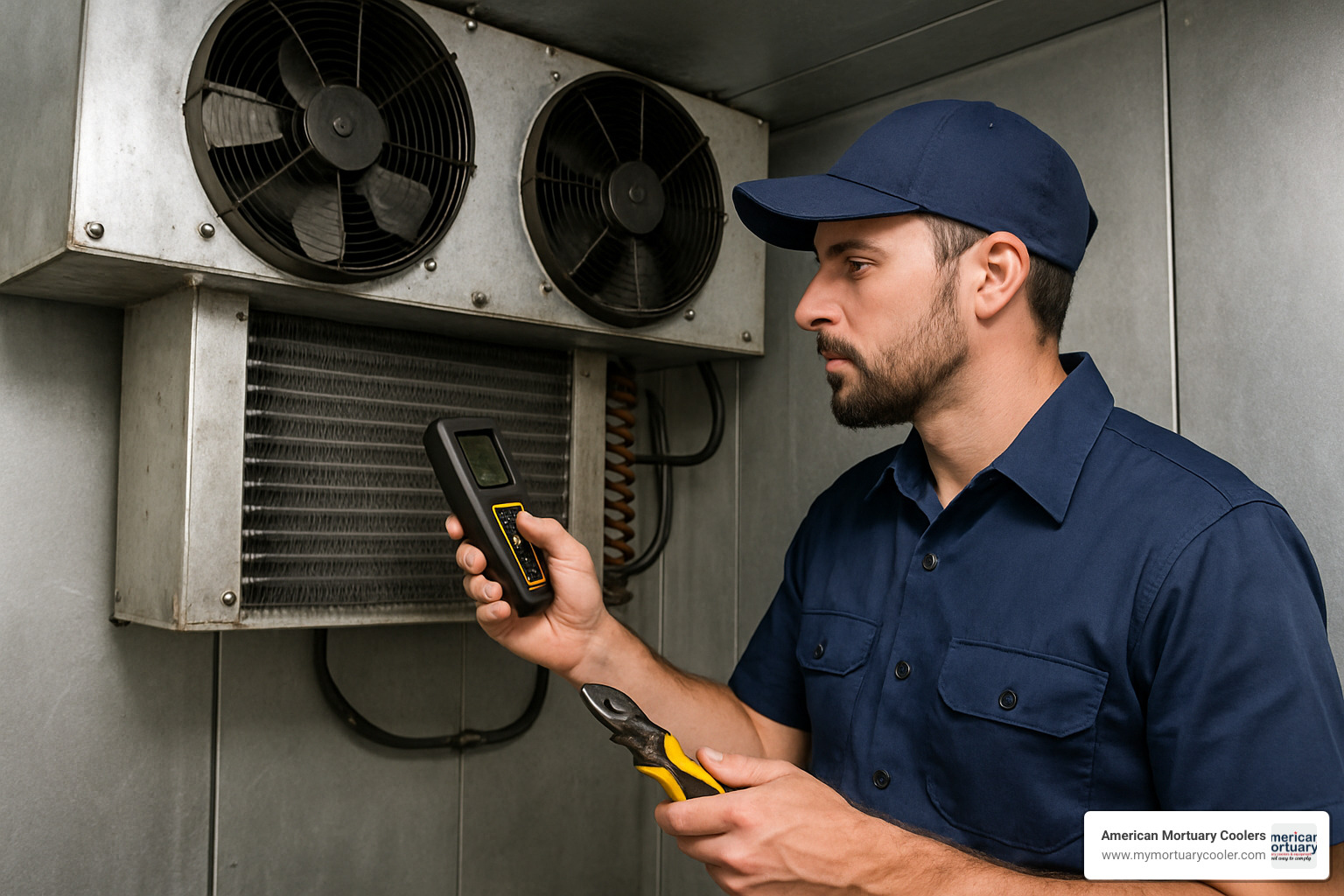
10-Point Walk-Through Checklist
Here's your systematic approach to evaluating any used unit:
- Panel Condition: Check for dents, warping, or insulation damage
- Door Gaskets: Ensure tight seals with no cracks or gaps
- Compressor Hours: Verify operating time and maintenance records
- Electrical Phase: Confirm power requirements match your facility
- Temperature Logs: Review historical performance data if available
- Floor Integrity: Test for soft spots or moisture damage
- Refrigerant System: Check for leaks and proper pressures
- Controls: Test all switches, thermostats, and safety devices
- Lighting: Verify all fixtures work and are vapor-proof rated
- Hardware: Check door latches, hinges, and safety releases
Ensuring Energy Efficiency & Regulatory Compliance
EISA compliance isn't just for new equipment - those Energy Independence and Security Act requirements apply to used units too. Make sure any unit you're considering meets current energy standards, or factor in upgrade costs to bring it into compliance.
Refrigerant type has become a bigger deal as older refrigerants get phased out. Units still running R-22 refrigerant might need expensive conversions to newer refrigerants like R-404A or R-449A. It's often worth paying a bit more for a unit that's already been converted.
Here's a money-saving tip many buyers miss: utility rebates. Many power companies offer rebates for energy-efficient refrigeration equipment, including qualifying used units. A quick call to your local utility might put hundreds of dollars back in your pocket.
Where to Find Deals & How to Move Them
Finding the perfect used walk in cooler requires knowing where to look and understanding what each marketplace offers. The good news? There are more options than ever before, each with its own personality and advantages.
Online marketplaces like eBay represent the wild west of used equipment shopping. You'll find everything from small self-contained units to massive warehouse systems, but buyer beware - you're often buying sight unseen from sellers who may not fully understand what they're selling. The selection is impressive, but do your homework on both the equipment and the seller.
Specialized dealers like American Wholesale Refrigeration and Barr Commercial Refrigeration offer a completely different experience. These folks live and breathe refrigeration equipment. They inspect units, provide some level of warranty support, and often handle the headache of delivery and installation. Yes, you'll pay a bit more than auction prices, but you're buying peace of mind along with your cooler.
Government auctions through GovDeals can be treasure troves for the adventurous buyer. 16'x12' combo unit that sold for just $1,025? That's the kind of deal that makes headlines, but it came with the responsibility of handling all removal and transportation. If you've got the logistics figured out, government auctions can deliver incredible value.
Craigslist and Facebook Marketplace shine when you need something local. No shipping costs, no freight headaches, and you can inspect before you buy. The downside? You're typically buying "as-is" from someone who may not know the first thing about commercial refrigeration. These platforms work best for smaller units or when you have the expertise to evaluate equipment yourself.
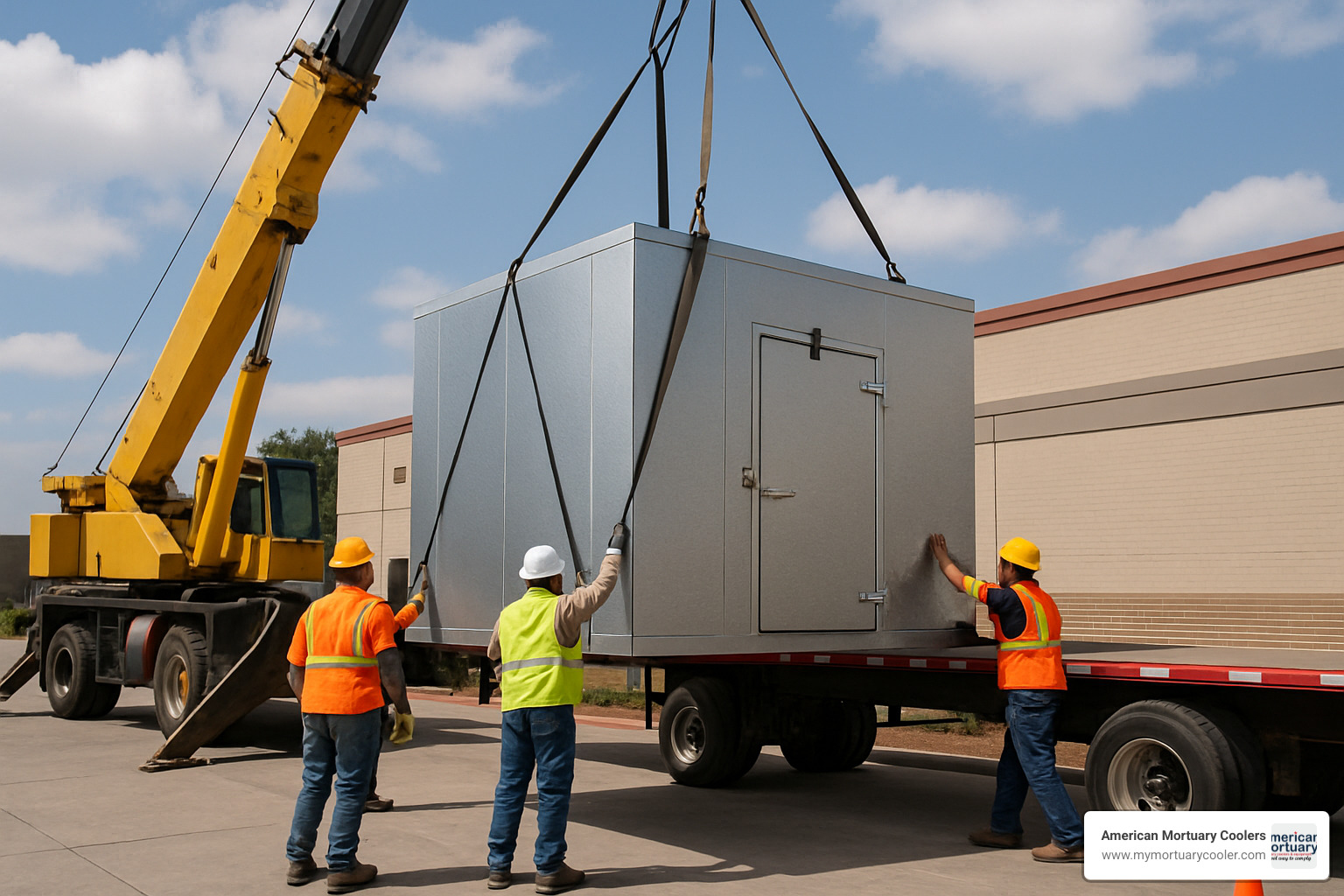
Shipping, Installation & Removal Tips
Here's where the rubber meets the road - getting your used walk in cooler from where it is to where you need it. Most dealers offer curbside delivery, which sounds helpful until you realize your 8'x10' cooler is sitting on the street and needs to get to your back kitchen or rooftop.
Forklift access is absolutely critical for anything larger than a small self-contained unit. Plan this ahead of time, not when the delivery truck is idling in your parking lot. For rooftop installations or tight spaces, you might need crane service, which can add $500-$1,500 to your project cost.
The panel labeling process separates the professionals from the amateurs. Reputable dealers will label every panel and provide detailed assembly diagrams that look like IKEA instructions for giants. If you're buying from an auction or private party, insist on proper labeling before anyone touches a screwdriver. Trust me on this one - trying to reassemble an unlabeled walk-in cooler is like doing a jigsaw puzzle blindfolded.
Refrigerant recovery isn't optional - it's the law. Only certified technicians can handle this part of the process, and for good reason. Factor in $200-$500 for professional refrigerant recovery when budgeting for your used equipment purchase.
Professional installation often pays for itself in the long run. Experienced installers can spot problems during assembly, ensure proper startup, and handle the inevitable "that doesn't look right" moments that come with used equipment. They've seen it all before, and their expertise can save you both time and headaches.
Can You Customize a Used Box?
One of the beautiful things about panel-construction walk-in coolers is their modular nature. Think of them as adult-sized building blocks that can be reconfigured, upgraded, and customized to fit your specific needs.
Adding glass doors to an existing unit is surprisingly straightforward if you have the right opening dimensions. Many businesses buy a standard used unit and then upgrade it with modern glass door systems for product display. It's like giving your cooler a retail makeover.
Floor kits can transform a unit that was originally installed without insulated floors. This upgrade is particularly valuable when relocating equipment to a space where floor insulation is necessary for efficiency or code compliance.
Remote condensers offer another popular customization option. You can replace a self-contained system with a remote condenser setup, moving the noisy compressor outside while keeping the evaporator inside for quieter operation and better temperature control. This modification is especially common when repurposing a unit from one application to another.
Selling Your Used Walk-In Cooler
Time to upgrade or relocate? Selling your used walk in cooler doesn't have to be a headache if you approach it strategically. The key is making your unit stand out in a competitive market where buyers have plenty of options.
Start with the basics - a thorough cleaning and honest assessment. Walk through your cooler with fresh eyes and ask yourself: "Would I buy this?" Address any obvious issues like burnt-out bulbs, loose door handles, or worn gaskets. These small investments can significantly impact your final sale price.
Preparation pays off in the used equipment market. Gather all your documentation including maintenance records, original specifications, and any warranty information. Buyers want to know what they're getting, and complete records suggest you've been a responsible owner.
Consider having a certified refrigeration technician inspect your unit before listing it. This professional evaluation serves two purposes: it identifies any issues you should address, and it provides buyers with confidence in their purchase. A recent inspection report can justify asking for top dollar.
Pricing strategy matters more than you might think. Research comparable units on eBay, specialized dealers, and local marketplaces to understand current market rates. Condition, age, and brand reputation all factor into value. A well-maintained Bally or Kysor unit will command higher prices than lesser-known brands.
Multiple listing platforms maximize your exposure to potential buyers. Specialized equipment dealers often offer consignment services where they handle the sale for a percentage of the final price. Online marketplaces like eBay and Craigslist give you direct access to buyers but require more effort on your part.
Don't overlook local opportunities either. Restaurant supply companies, food service equipment dealers, and even other businesses in your area might be interested. Sometimes the best deals happen through word-of-mouth referrals.
Offering limited warranties can set your unit apart from the competition. Even a simple 30-day guarantee on major components shows confidence in your equipment and provides buyer peace of mind. This small gesture often translates into higher sale prices and faster transactions.
Decommissioning requires planning once you find a buyer. Proper refrigerant recovery by certified technicians isn't optional - it's required by law. Factor this cost into your pricing, or make it clear who's responsible for handling the refrigerant removal.
Panel labeling becomes crucial if your buyer needs to relocate the unit. Take photos during disassembly and clearly mark each panel for easy reassembly. This attention to detail reflects well on you as a seller and helps ensure a smooth transaction.
The used refrigeration market stays active year-round, but timing can affect your sale price. Spring and early summer typically see higher demand as restaurants and food service operations prepare for busy seasons. If you're not in a hurry, consider timing your sale to coincide with peak demand periods.
Frequently Asked Questions about Used Walk-In Coolers
When you're considering a used walk in cooler, you probably have questions. After helping countless businesses find the right refrigeration solutions, I've heard these same concerns again and again. Let me share what I've learned from years in the industry.
What's the expected lifespan of a used walk-in cooler?
Here's the good news - a quality used walk in cooler isn't anywhere near the end of its useful life. With proper maintenance, these units routinely deliver 15-20 years of reliable service. I've seen Bally and Kysor units still running strong after 25 years.
The secret is understanding what wears out first. The insulated panels are built to last decades - they're the strong foundation of your investment. It's the refrigeration components that need attention over time. Compressors and condensing units typically need replacement every 10-15 years, but that's true whether you buy new or used.
Think of it like buying a used car with a rebuilt engine. You're getting proven reliability at a fraction of the new price, and you know exactly what to expect for maintenance down the road.
Are warranties available on second-hand units?
This varies dramatically depending on where you buy. Specialized dealers like American Wholesale Refrigeration typically offer 30-90 day warranties on major components. They've inspected and reconditioned the units, so they're confident enough to back their work.
Some dealers go even further with comprehensive coverage on fully reconditioned units. They'll stand behind the compressor, evaporator, and control systems because they've already addressed any potential problems.
Private party sales and government auctions are different stories - these are typically "as-is" purchases with no warranty protection. That's part of why auction prices can be so attractive, but you're taking on all the risk yourself.
The key is matching your risk tolerance with the right buying channel. Need peace of mind? Go with a dealer who offers warranty coverage. Comfortable evaluating equipment yourself? Auctions might offer better deals.
How often should I service a used walk-in box?
A used walk in cooler needs attention more frequently than new equipment, at least initially. I recommend quarterly maintenance during your first year of ownership. This includes cleaning condenser coils, checking refrigerant levels, and inspecting door gaskets and seals.
Annual professional service should include comprehensive system evaluation, control calibration, and addressing any wear items before they become problems. Your technician can spot issues early and help you budget for future maintenance needs.
The reality is that used units often come with some deferred maintenance from previous owners. Maybe the coils haven't been cleaned regularly, or minor issues were ignored. Your first year is about catching up on that maintenance and establishing a baseline for future service.
Once you've addressed any initial issues, a well-maintained used unit requires the same service schedule as new equipment. The investment in proper maintenance pays dividends in reliability and energy efficiency.
Conclusion
Finding the right used walk in cooler doesn't have to be overwhelming. With savings of up to 50% compared to new equipment, the used market opens doors for businesses that might otherwise struggle with refrigeration costs. Whether you need a compact unit for a small café or a warehouse-sized system for distribution, quality used equipment is out there waiting.
The key is knowing what to look for and where to look. Take time to inspect thoroughly, understand your power requirements, and budget realistically for any needed repairs. A professional evaluation might cost a few hundred dollars upfront, but it can save thousands in unexpected problems down the road.
Your used walk in cooler purchase is an investment in your business's future. When you buy smart - checking panel integrity, testing refrigeration systems, and working with reputable dealers - you're setting yourself up for years of reliable cold storage. The money you save can go toward other critical business needs, from inventory to marketing to staff.
At American Mortuary Coolers, we've seen how the right refrigeration equipment transforms operations. While we specialize in mortuary cooling solutions, the principles of smart equipment buying remain the same across all industries. Quality matters, inspection is crucial, and working with experienced suppliers makes all the difference.
The used refrigeration market keeps getting better. More dealers are offering warranties, inspection standards are improving, and online platforms make it easier than ever to find exactly what you need. For businesses ready to do their homework, a quality used walk in cooler represents one of the best values in commercial equipment today.
For additional insights on finding cost-effective refrigeration solutions, our guide on More info about finding affordable mortuary supplies covers strategies that work for all types of commercial refrigeration purchases.
The perfect used unit is out there. It might take some patience and careful evaluation, but when you find it, you'll have reliable refrigeration that serves your business for decades while keeping more money in your pocket where it belongs.

















